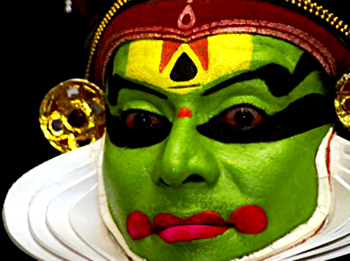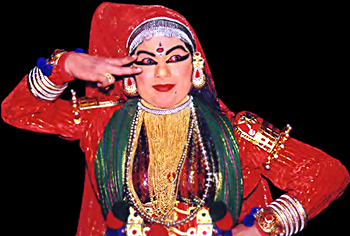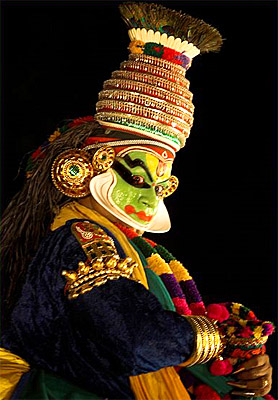 Makeup in Kathakali preserves some of the highly symbolic stylizations of Indian art. This make-up is distinctively Indian. Certain colours represent certain characteristics and moods. The Natyashastra refers to facial make-up and devotes one chapter to aharyabhinaya where it considers the symbolism of colour in facial make-up and costumes. Certain colours are associated with particular moods and sentiments.
Makeup in Kathakali preserves some of the highly symbolic stylizations of Indian art. This make-up is distinctively Indian. Certain colours represent certain characteristics and moods. The Natyashastra refers to facial make-up and devotes one chapter to aharyabhinaya where it considers the symbolism of colour in facial make-up and costumes. Certain colours are associated with particular moods and sentiments.
Facial Make-Up
The colours play a key role in Kathakali. Each colour is symbolic. Light green represents Sringara, red Raudra and yellow Adbhuta. Kathakali follows these basic colour patterns. Its use is to transform the actor into a god or a demon. Once the actor has the make-up he is transformed into the character which he is playing. Even before his first stage entrance no one addresses the actor by his own name once he has put on the make-up. The make up guide is an important person both at the training stage and also at the performing stage. He is known as Chottikkaran, who has been through a strenuous art training , from drawing designs on a pot and a coconut shell to preparing his own colours by grinding, soaking, and mixing them to desired consistency.
The basic makeup is green if the characters are sattyika. The cheeks, up to the jaw-bone, are covered with a light green paste. The eyes are elongated to give them a design which can be described as lotus-eyed. The forehead has a white pigment and can take different designs depending upon the particular character.
The jaw-bone has a pasting of cut-outs either of paper to give the face enlarged dimensions. With the costume, the make-up transforms the actor to superhuman stature.
The make-up is made of ground-rice and lime and it is along the arc of this white paste that the cuts of the false chin and jaw are struck.
When these characters assume the ferocious mood, a large moustache in black is drawn on the basic green make-up along the upper lip reaching to the upper cheek-bone. On the basic green makeup an oval red and white design is made on the nose and on the upper cheek. A white spot of pith is attached to the nose which makes the characters more fantastic than human.
Types of Tadi
 The villains, anti-heroes, demons receive a make-up called the beard or Tadi. The three traditional types of Tadi are the red, black and white. The red beard is for the evil character who is mostly involved in destructive deeds. The basic colour scheme of the face is red, with upper portion of the face painted black and the lower portion painted red. The eyes have a square patch of black collyrium giving them a frightening look. The white paste is not applied along natural contours of the jaw-bone. The paper cut-outs are also square and put out from the line of the nose horizontally on either side of the face. Along with this there is an elongation of the chin by a flat false beard which gives these characters an ominous appearance. There are two fangs protruding from the lips. They succeed in creating an atmosphere of the nether world on the stage by the manner they scream and cry. The black beards are different as they do not indicate the anti-heroes and the demons. They symbolize the aborigines and the off-beat characters like Lord Siva disguised as hunter also called Kirata. There are many fantastic designs in white and red on this. The Kari characters have black beards.
The villains, anti-heroes, demons receive a make-up called the beard or Tadi. The three traditional types of Tadi are the red, black and white. The red beard is for the evil character who is mostly involved in destructive deeds. The basic colour scheme of the face is red, with upper portion of the face painted black and the lower portion painted red. The eyes have a square patch of black collyrium giving them a frightening look. The white paste is not applied along natural contours of the jaw-bone. The paper cut-outs are also square and put out from the line of the nose horizontally on either side of the face. Along with this there is an elongation of the chin by a flat false beard which gives these characters an ominous appearance. There are two fangs protruding from the lips. They succeed in creating an atmosphere of the nether world on the stage by the manner they scream and cry. The black beards are different as they do not indicate the anti-heroes and the demons. They symbolize the aborigines and the off-beat characters like Lord Siva disguised as hunter also called Kirata. There are many fantastic designs in white and red on this. The Kari characters have black beards.
The white beard also known as veluppu Tadi indicates the third type of half-human gods like Lord Hanuman. White is the basic make-up. The characters are gentle though they are capable to assume ferocious forms. The Lion-God or Narasimha has different category of make-up. Yellow is the basic make-up of such characters, which represents Adbhuta or wonder. This make-up is a class by itself and one of the most effective make-ups of this dance drama.
Other types of characters have a basic pink makeup on the face without any attempt at masking. They are known as the Brahmins, minukku; women, messengers, rishis, and others.
Head Gear or Mudis
 Headgears also called the Mudis are carved either from wood or cane. There is a particular cane-shaped crown headgear for Krishna which is also worn by Lava and Kusha and other children. The other good heroes wear a more elaborate low conical crown with a smell disc. The characteristic features of these mudis are that they have in set mirrors. The red-bearded characters wear a headdress similar to those noble characters. However the crown is higher and the disc is larger while the villains and demons assume huge proportions. A distinctive headgear is designed for characters like Hanuman, Narasimha and Siva disguised-as-a-hunter.
Headgears also called the Mudis are carved either from wood or cane. There is a particular cane-shaped crown headgear for Krishna which is also worn by Lava and Kusha and other children. The other good heroes wear a more elaborate low conical crown with a smell disc. The characteristic features of these mudis are that they have in set mirrors. The red-bearded characters wear a headdress similar to those noble characters. However the crown is higher and the disc is larger while the villains and demons assume huge proportions. A distinctive headgear is designed for characters like Hanuman, Narasimha and Siva disguised-as-a-hunter.
The symbolism that is followed in the makeup and headgears is carried out in the costume colours worn by the various characters. The green painted characters usually wear a jacket of purple, blue or yellow. Red jacket ones wear red beards and the white jacket ones wear white beards while the scarves which hang on either side follow the colour patterns set by the make-up. The lower half costume of Kathakali dancer is common to all types excepting the minukku characters. The actor`s proportions are enlarged by using heavily plaited skirts.




